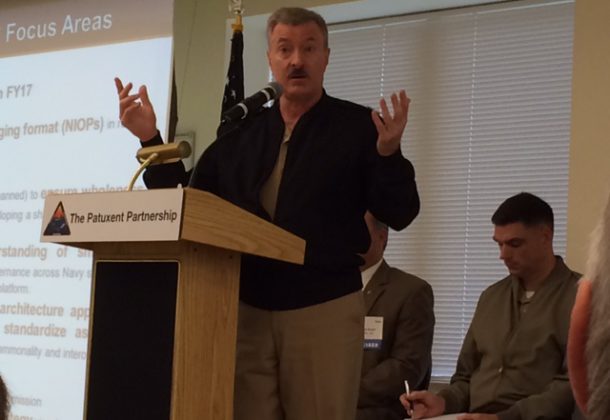Autonomous Tools Urgent Needs of Warfighter

RADM Mark Darrah headlines The Patuxent Partnership briefing, “Autonomous Systems Capabilities: The View from Pax River.”
The overarching theme from speakers at the Patuxent Partnership’s April 12 presentation, “Autonomous Systems Capabilities: The View from Pax River,” is that time is of the essence. The warfighter needs solutions yesterday – before you’ve even thought of designing and testing them.
Furthermore, leveraging innovation across all services, and within services, is more urgent than ever. Efficiency needs to improve. Legacy workforces need further education to be able to continue to give their best. Utilizing the perspective of the younger workforce is important. Growing tomorrow’s workforce is an enormous task and a huge opportunity that must be undertaken – you guessed it – yesterday.
NAS Patuxent River has the toolkit and the mandate – and the challenge, as RADM Mark Darrah, Program Executive Officer for Unmanned Aviation and Strike Weapons, told his listeners, “to apply new rules to new things.” The new things are autonomous vehicles, which can foster a shift to “autonomous missions” that give the warfighter the flexibility to respond when needed, how needed.
To meet the challenge, RADM Darrah ticked off three FY16 focus areas for his program: agile staffing, cyber awareness across all program offices, and the use of standardized UAS data messaging to facilitate interoperability. He is also an advocate of open architecture that “allows vendors to test their interface to make sure it works as they make proposals. Some say this approach is too prescriptive, but it actually gives us more options.”
The integrity of the reams of data now available from UAV operations, and the ability to interpret it, remain challenging. “The pedigree of data in the tactical cloud keeps me up at night,” RADM Darrah said, citing the need to know the data source, when it was last updated, its cleanliness, and who is responsible for cleaning it. Ultimately, he asked, is the data’s value immediately discernible to the warfighter: “Can you find the data you need at the tactical moment you deliver a weapon?”
Pete Heasley, technical director of the UAS Test Directorate at Webster Field, touted the versatility that’s been introduced there to blend the needs of piloted and pilotless vehicles, a process that’s constantly being tweaked. UAVs have been a part of Webster Field since the launch of the V-6 UAV in 1986, “when Bruce Willis was still making albums,” he said. Webster Field has been adding capacity to conduct tests and demonstrations for external customers “who partner with a NAWCAD effort that shows some benefit to the enterprise.” Webster Field’s testing of small UAVs (such as 15-pound quadracopters flying below 200 feet in altitude) has moved to Kitt’s Point (the St. Inigoes State Forest) to help balance the manned-unmanned airspace demands at Webster Field.
Mr. Heasley is an enthusiastic booster of Webster Field’s annual student robotics and UAV competition for its potential to offer up ideas and start careers. This year’s competition, scheduled for June 15-19, will again bring together “a cornucopia of bright people,” he says. “It’s an amazing opportunity, a platform to hire and interview.”
Steve Kracinovich, director of NAVAIR Autonomous Initiatives, talked about the need for culture change on several levels, starting with the control panel: “We need to migrate from thinking of people as vehicle operators, to mission operators,” he said. He discussed the need to reassure the broader US culture about invasion of privacy concerns posed by the proliferation of drones in everyday life. He also endorsed embracing open architecture to accelerate innovation “so we can integrate third-party applications, including from smaller businesses and non-DoD-traditional entities.
“The real problem is our own processes,” Mr. Kracinovich said. “We need to move away from the ‘too-big-to-fail’ system, the vendor lock.” He favors “coopetition,” in which a wider range and type of vendor partners with military programs.
COL Eldon Metzger, Program Manager of the Navy and Marine Corps Small Tactical Unmanned Aircraft System Program (PMA-263), says “the operational tempo is increasing,” constantly being altered and accelerated by what the warfighter needs. COL Metzger says in considering proposals, he’s “searching for a ready-made solution [from industry] because it reduces the footprint of time it takes to get it to the warfighter.” One urgent area: “How can the industry help us with the cost of repair and spare parts?” COL Metzger stressed the need for constant communication between and within industry and program offices before venders move ahead with prototypes. He can’t make a purchase unless he has a requirement to solve the problem a vendor’s product is supposed to solve.
Dave Seagle is the Demonstration (BAMS-D) program lead for Persistent Maritime Unmanned Aircraft Systems (PMA-262) Broad Area Maritime Surveillance. He is tasked with supporting a family of unmanned and manned systems, a transformational mixed force that will see the transition from BAMS-D to Triton. BAMS-D supports the testing and evaluation that is leading to risk reduction for Triton, which is key to the Navy’s intelligence, surveillance, reconnaissance and targeting transition plan, Mr. Seagle said.
The BAMS-D T&E has offered important lessons learned for the benefit of Triton, he said:
- The need for 360-degree radar
- The importance of getting off the Ka band and onto the military wide-band satellite
- A generator upgrade
- More robust wing strength to protect against wind gusts
- Striving to push data down to the warfighter in near-real time, with a goal of actionable data
- Mitigating risks that could lead to the loss of the aircraft
Regarding the last, aircraft loss: Even with all the efforts to minimize risks of all kinds in these advanced technologies, two basic threats persist, courtesy of Mother Nature: hail and birds.
To learn more about the Patuxent Partnership and its programs, visit its Leader Page.























